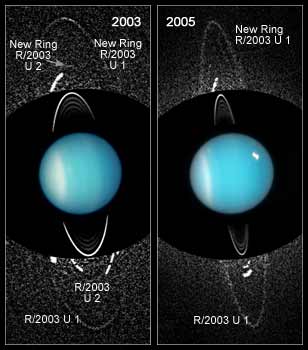The diameter of the big ring is twice the diameter of the known rings. It is therefore a second ring system, distant from the planet

The Hubble Space Telescope photographed a pair of new rings and two small moons orbiting the planet Uranus.
The diameter of the big ring is twice the diameter of the known rings. It is therefore a second ring system, distant from the planet. One of the new moons shares one of the rings in its orbit. An analysis of the details captured by Hubble reveals that the family of Uranus' inner moons has changed beyond recognition in the past decade.
"The discovery of these two interacting rings and the moons that accompany them will help to better understand how our solar system was formed and exists, which is an essential component of NASA's scientific goals," says Dr. Jennifer Weissman, Hubble Program Scientist at NASA Headquarters.
Since the dust surrounding Uranus is expected to decay by swirling outward, there must be a source to replenish the material. "The new discovery illustrates that Uranus has a dynamic and vibrant system of rings and moons," says Mark Showalter of the ST Institute in Mountain View, California.
Showalter and Jack Lissuser of NASA's Ames Research Center in California, proposed that the outer ring receives the material it needs from a recently discovered 20 km diameter moon, which was named Mav, and which was first observed by Hubble in 2003.
Meteorite impacts regularly cause dust to be thrown from the surface of Mav. The dust spreads out into the ring surrounding Uranus. Mab's ring receives a fresh infusion of dust with each hit. Nature takes care of a constant supply of new dust while the old dust is blown out or splashed back to the moon.
Since the new rings are almost transparent, it will be easier to see them when they face us in their full width. The new rings increase in brightness each year as Uranus makes its way to the equinox when the Sun shines just above the equator. This is expected to happen in 2007, when all the rings will turn their broad side towards Earth and it will be easier to study them. The research will appear in the upcoming issue of the journal Science.
